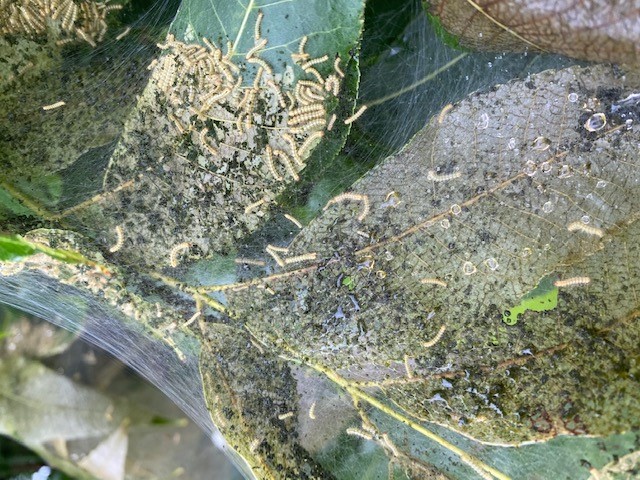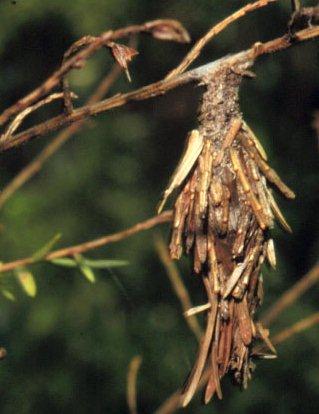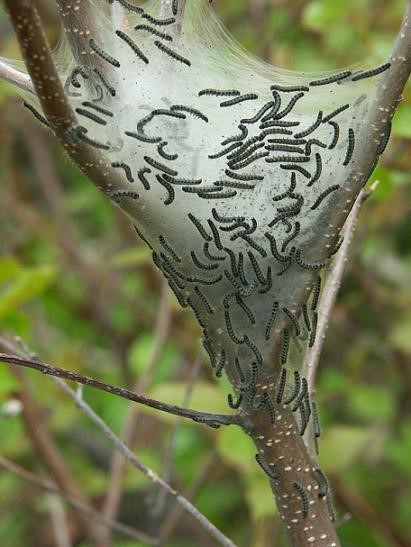Webworms or Bagworms?
go.ncsu.edu/readext?381058
en Español / em Português
El inglés es el idioma de control de esta página. En la medida en que haya algún conflicto entre la traducción al inglés y la traducción, el inglés prevalece.
Al hacer clic en el enlace de traducción se activa un servicio de traducción gratuito para convertir la página al español. Al igual que con cualquier traducción por Internet, la conversión no es sensible al contexto y puede que no traduzca el texto en su significado original. NC State Extension no garantiza la exactitud del texto traducido. Por favor, tenga en cuenta que algunas aplicaciones y/o servicios pueden no funcionar como se espera cuando se traducen.
Português
Inglês é o idioma de controle desta página. Na medida que haja algum conflito entre o texto original em Inglês e a tradução, o Inglês prevalece.
Ao clicar no link de tradução, um serviço gratuito de tradução será ativado para converter a página para o Português. Como em qualquer tradução pela internet, a conversão não é sensivel ao contexto e pode não ocorrer a tradução para o significado orginal. O serviço de Extensão da Carolina do Norte (NC State Extension) não garante a exatidão do texto traduzido. Por favor, observe que algumas funções ou serviços podem não funcionar como esperado após a tradução.
English
English is the controlling language of this page. To the extent there is any conflict between the English text and the translation, English controls.
Clicking on the translation link activates a free translation service to convert the page to Spanish. As with any Internet translation, the conversion is not context-sensitive and may not translate the text to its original meaning. NC State Extension does not guarantee the accuracy of the translated text. Please note that some applications and/or services may not function as expected when translated.
Collapse ▲There is often confusion as to which insect pest is called webworms and which is called bagworms. Some think that bagworms and webworms refer to the same insect pest. There are three different insects on trees where the names are sometimes confused or interchanged. Knowing the difference will help in determining best management options along with optimal time to manage. The three insects are fall webworms, bagworms, and Eastern tent caterpillar.
Fall webworms are sometimes mistakenly called bagworms. Fall webworms are the webs you can see at the ends of branches on many trees during late summer into the fall. Fall webworms are a mass of webbing at the end of tree branches. The webs contain many tiny, hairy caterpillars. Most often fall webworms are found on pecan, sourwood, and persimmon trees but can also feed on over 600 species of trees and shrubs. Fall webworms can be easily destroyed or disrupted by pulling down webs that are within reach with a stick or pole. Pulling down the webs exposes caterpillars to birds and wasp. Carbaryl (Sevin) can be used to spray webs within reach. When using an insecticide for fall webworms, spray the foliage closest to the web mass. Spraying the web itself does not give good contact with the caterpillars. If the webs are not within reach do not worry, although they are unsightly they usually do not harm the tree’s overall health.
Bagworms are small (1/8″ to 2″ long), diamond-shaped silk bags. The worms make and live inside the bags. The bags can be easily missed because the worms camouflage the bags with parts of the tree. These bagworms are often found on arborvitae, Leyland cypress, and juniper. The easiest way to control bagworms is to pick or clip them off the tree limbs and drowned the bags in soapy water. If using insecticides, they need to be used in June or early July when the bagworms are small or else the insecticides will not penetrate through the bag and reach the worm. Insecticides that can be used to control bagworms include: B.t. (Dipel), carbaryl (Sevin), and malathion.
The Eastern tent caterpillar is often called webworms, but there are two major differences between the two insects. The Eastern tent caterpillar forms webs in the center of a tree’s canopy in late-spring into summer, while the fall webworms form webs at the end of tree branches in late-summer into the fall. The Eastern tent caterpillars are black with a gold or white stripe down the back. Eastern tent caterpillars are most often found on wild cherry, crabapple, and apple trees but many other kinds of trees are occasionally infested. Trees that are defoliated for several years by Eastern tent caterpillars may decline noticeably. Because the Eastern tent caterpillars spend the winter inside the egg masses, one effective method of controlling the caterpillars is to remove and destroy the egg masses before the caterpillars hatch. If the caterpillars have already hatched, the tents can be pulled down with a stick and the caterpillars crushed. Carbaryl (Sevin) is labeled for controlling Eastern tent caterpillar.
It is important to note for safety reasons that it is not recommended to use fire to destroy fall webworms or Eastern tent caterpillars as a fire can set up an extremely dangerous situation. Fire may get out of hand and destroy the tree, endanger the person, and nearby properties.
Maybe this will reduce some of the confusion on which insect pests are called bagworms, webworms, and tent caterpillars. All three are common on many trees in the landscape. By knowing how to tell the difference between the three, one can determine when to take the best control measures.
Recommendations for the use of agricultural chemicals are included in this article as a convenience to the reader. The use of brand names and any mention or listing of commercial products or services in this article does not imply endorsement by North Carolina Cooperative Extension nor discrimination against similar products or services not mentioned. Individuals who use agricultural chemicals are responsible for ensuring that the intended use complies with current regulations and conforms to the product label. Be sure to obtain current information about usage regulations and examine a current product label before applying any chemical.
Jessica Strickland is an agriculture extension agent, specializing in horticulture for North Carolina Cooperative Extension in Wayne County.
Learn More!
- Sign up for the Wayne County Extension Gardening email list to receive timely gardening tips.
- Follow us on Facebook and Instagram.
- Visit the North Carolina Extension Gardener Plant Toolbox to discover more plant ideas for your garden.







